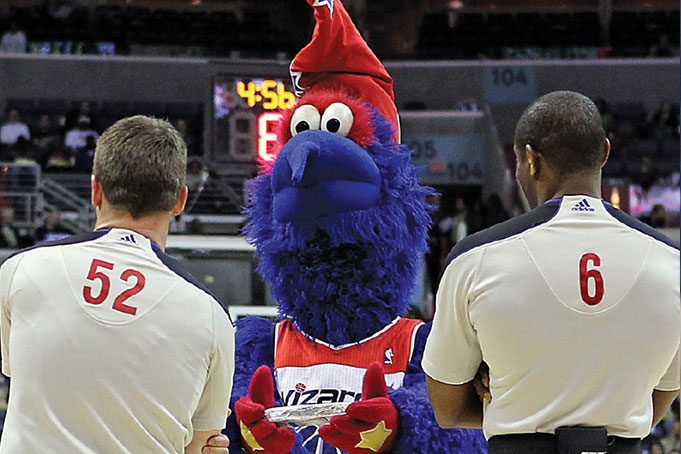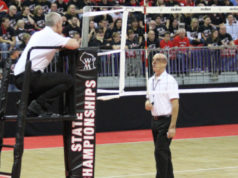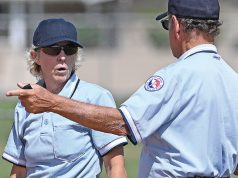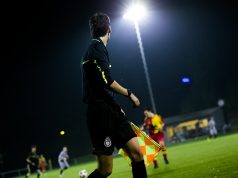Referees and umpires around professional, college and even high school sports unfortunately must face the challenges of how to deal with mascots who either affect play on the field or demean players or officials.
Many years ago, Bill Spooner was a young NBA referee who was in the process of gaining respect from players and coaches. But he gained more notoriety for taking a prop away from New Jersey Nets mascot Super Dunk, a story Spooner still remembers with a smile today.
“There were a few close calls that had gone against (the host Nets) and their mascot brought out an eye chart and was using it to the point where he was attempting to demean us,” said Spooner, recently retired NBA referee. “So I took it from him and tossed it on the scorer’s table. It was just my reaction at the time.”
That action gained widespread media attention, particularly in the media-heavy New York/New Jersey market, but Spooner contends he did the right thing. Spooner hasn’t had to admonish other mascots since.
Retired NFL referee Dick Hantak had an incident in which a mascot affected a game he was working. In 1996, Hantak was refereeing a Panthers game in North Carolina when Carolina mascot Sir Purr jumped on a punted ball that was bouncing around in the end zone.
Unbeknownst to Sir Purr, the ball was still live, even if it appeared no Panther players were going to pick up the ball on an attempted return. While running down the field, Hantak was aware that his back judge had thrown a penalty flag on the field after the mascot’s antics, and quickly resolved the matter.
“I explained to (the crewmate) that we didn’t want to penalize the home team,” Hantak said. “Obviously it wasn’t the fault of the players.” What Hantak did, though, during the ensuing timeout was give Sir Purr a stern lecture.
“I told him if he ever came on the field during play again, I would make sure he would never work another NFL game,” said Hantak, laughing. “I think he got the message.”
Mascots, like referees and players, are only human, despite their furry exterior. And sometimes, the emotions of those obviously biased mascots will get the better of them.
Hooter the Temple Owl was ejected from a basketball game for making an inappropriate gesture to a referee following a Temple technical foul.
Then-Temple coach John Chaney was as shocked by the incident as anyone. After the game, which Temple lost to Penn, 68-62, Chaney told reporters with a wry smile, “I can’t believe that’s ever happened before. Usually our mascot is soft.”
But the Temple Owl ejection is just the latest in a long line of referee mascot run-ins. Here’s a short list of some of the more memorable incidents throughout the years:
- In December 1990, NBA referee Ed Middleton allowed Atlanta Hawks forward Jon Koncak to shoot an extra free throw after the Houston Rockets’ mascot stood behind the basket waving a poster of a bikini-clad woman.
- In 1992, the NCAA Division I Baseball Committee ruled that the College World Series that year would not include its own mascot, the Maniac. That decision was made because John Routh, who played the role of the Maniac, organized the umpires to dance the hokey-pokey between innings of the 1988 College World Series title game.
- A few months later in 1992, Western Athletic Conference football official Clair Gausman was inadvertently run over by the Texas Tech horse following a first-quarter touchdown in the Red Raiders’ game against Wyoming. Gausman received only minor injuries.
- During a Single-A baseball game in April 1993, Memphis Chicks’ mascot Chief Chickasaw was ejected for pretending to “moon” umpire Chris Hoffarth.
- Southern Methodist University mascot Peruna was ejected by referee Bill Gracey in February 1998, for pretending to give Gracey two technical fouls after Gracey had tossed out SMU coach Mike Dement for arguing.
- The University of Miami mascot, Sebastian the Ibis, ran onto the field during the Sugar Bowl played Jan. 2, 2001, and hugged a player who scored a late-game touchdown. The move drew a 15-yard unsportsmanlike conduct penalty, forcing a longer try. Then-Hurricane coach Butch Davis could be seen mouthing the words, “Get that s.o.b. off the field!”
All humor aside, although such stories make good fodder for the sports pages, officials’ run-ins with mascots aren’t usually particularly humorous when you’re the official who has to deal with it.
Jason Dempsey spent three years in college as Sparty, the Michigan State University mascot, in the mid- 1990s. Dempsey said that he was given strict directives from university officials that his role was merely to entertain and excite MSU fans, and not to become part of the game.
“It was a real rush,” Dempsey said, “but you had to check yourself sometimes because your adrenaline would get going and it was so easy to get really involved in the game.”
That’s presumably what happens when a mascot steps over the line and gets ejected. Obviously, some referees and umpires don’t mind sharing a light moment by playing along with a mascot’s antics during a timeout or between innings, but when a mascot starts to interfere with the game or with the job at hand, that’s when you need to take action.
“There’s a real lack of respect for officials in general and if a mascot interferes with a game, or is trying to bring attention to you, it can be over the line,” Spooner said. “I do know the NBA mascots really leave us alone and know we have a job to do now and are very professional so we are lucky.”
But Spooner added that might not be the case at all levels of competition. “I think all referees just have to make sure that any action they take against mascot is justified,” he said, noting that even though the role of a mascot might seem frivolous to some people, they are also there to do a job.
But in the grand scheme of any game, it’s good advice to realize that any mascot who intentionally interferes with a game or who intentionally tries to show up the officials should be dealt with swiftly and given little tolerance. In a high school or college game, talk to the game manager or athletic director and let him or her deal with the issue.
What's Your Call? Leave a Comment:
Note: This article is archival in nature. Rules, interpretations, mechanics, philosophies and other information may or may not be correct for the current year.
This article is the copyright of ©Referee Enterprises, Inc., and may not be republished in whole or in part online, in print or in any capacity without expressed written permission from Referee. The article is made available for educational use by individuals.



















